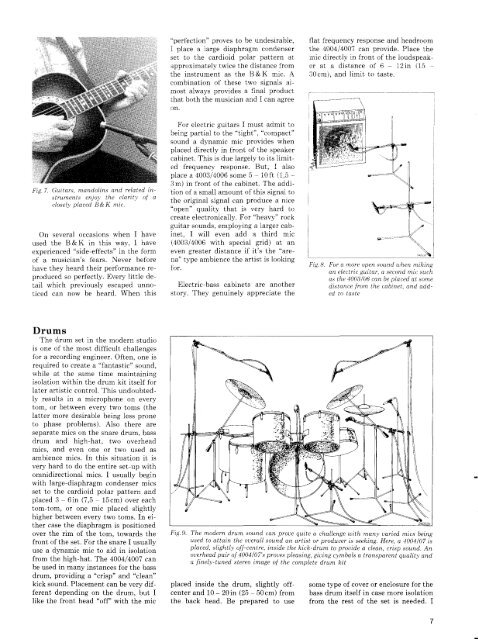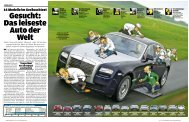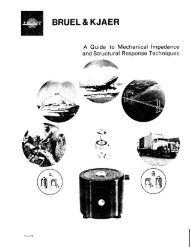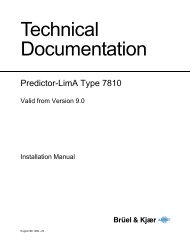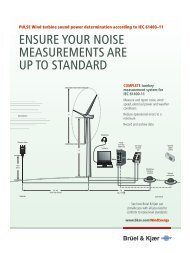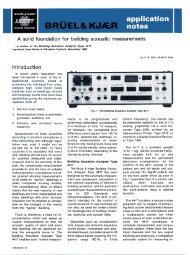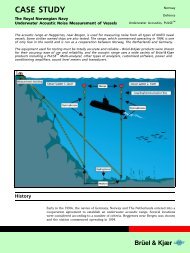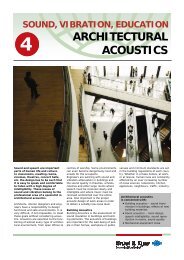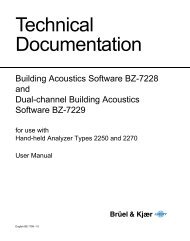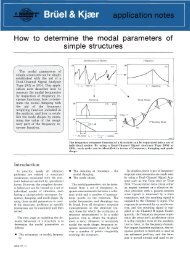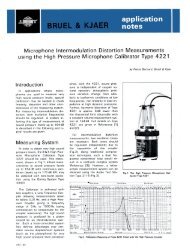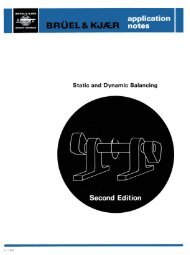The Use of B&K Omnidirectional Microphones for Modern Recording
The Use of B&K Omnidirectional Microphones for Modern Recording
The Use of B&K Omnidirectional Microphones for Modern Recording
You also want an ePaper? Increase the reach of your titles
YUMPU automatically turns print PDFs into web optimized ePapers that Google loves.
"perfection" proves to be undesirable. fiat frequency response and headroom<br />
I place a large diaphragm condenser the 4004/4007 can provide. Place the<br />
set to the cardioid polar pattern at mic directly in front <strong>of</strong> the loudspeak-<br />
approximately twice the distance from er at a distance <strong>of</strong> 6 - 12in (15 -<br />
the instrument as the B&K mic. A 30cm), and limit to taste.<br />
combination <strong>of</strong> these two signals al<br />
most always provides a final product<br />
that both the musician and I can agree<br />
on.<br />
For electric guitars I must admit to<br />
being partial to the ''tight", "compact"<br />
sound a dynamic mic provides when<br />
placed directly in front <strong>of</strong> the speaker<br />
cabinet. This is due largely to its limit<br />
ed frequency response. But, I also<br />
place a 4003/4006 some 5 - 10 ft (1,5 -<br />
3 m) in front <strong>of</strong> the cabinet. <strong>The</strong> addi-<br />
Fig. 7. Guitars, mandolins and related in- tion <strong>of</strong> a gmall amount 0f this signal to<br />
struments enjoy the clarity <strong>of</strong> a the ojigingl gi { can produce a mce<br />
closely placed B&K mic. ,, „ .., . , . , i<br />
open quality that is very hard to<br />
create electronically. For "heavy" rock<br />
guitar sounds, employing a larger cab-<br />
On several occasions when I have inet, I will even add a third mic<br />
used the B&K in this way, I have (4003/4006 with special grid) at an<br />
experienced "side-effects" in the <strong>for</strong>m even greater distance if it's the "are-<br />
<strong>of</strong> a musician's fears. Never be<strong>for</strong>e na" type ambience the artist is looking<br />
, i i j , i • n i- rig. 8. For a more open sound when miking<br />
have they heard their per<strong>for</strong>mance re- tor. to J , , . , . f<br />
^ an electric guitar, a second mic such<br />
produced so perfectly. Every little de- as the 4003/06 can be placed at some<br />
tail which previously escaped unno- Electric-bass cabinets are another distance from the cabinet, and add<br />
uced can now be heard. When this story. <strong>The</strong>y genuinely appreciate the ed to taste<br />
Drums<br />
<strong>The</strong> drum set in the modern studio<br />
is one <strong>of</strong> the most difficult challenges<br />
<strong>for</strong> a recording engineer. Often, one is<br />
required to create a "fantastic" sound,<br />
while at the same time maintaining<br />
isolation within the drum kit itself <strong>for</strong><br />
later artistic control. This undoubted<br />
ly results in a microphone on every<br />
torn, or between every two toms (the<br />
latter more desirable being less prone<br />
to phase problems). Also there are<br />
separate mics on the snare drum, bass<br />
drum and high-hat, two overhead<br />
mics, and even one or two used as<br />
ambience mics. In this situation it is<br />
very hard to do the entire set-up with<br />
omnidirectional mics. I usually begin<br />
with large-diaphragm condenser mics<br />
set to the cardioid polar pattern and<br />
placed 3 - 6in (7,5 - 15 cm) over each<br />
tom-tom, or one mic placed slightly<br />
higher between every two toms. In ei<br />
ther case the diaphragm is positioned<br />
over the rim <strong>of</strong> the torn, towards the Fig. - 9 - <strong>The</strong> modern drum sound can prove quite a challenge with many varied mics being<br />
front <strong>of</strong> the set. For the snare I usually use d to attain the overall sound an artist or producer is seeking. Here, a 4004/07 is<br />
use a dynamic mic to aid in isolation place u d > f 8h ? ly ?f"*> inside th , e kick ~ drum to P mde a dean > C P sound - An<br />
f.nm tu i^u v,Q+ Ti a Ar\(\AiA(\cn ..„ overhead pair <strong>of</strong> 4004/07 s proves pleasing, giving cymbals a transparent quality and<br />
trom the nigh-Hat. lne 4UU4/4UU/ can a fmdy^uned stereo image <strong>of</strong> the compiete drum kit<br />
be used in many instances <strong>for</strong> the bass<br />
drum, providing a "crisp" and "clean"<br />
kick sound. Placement can be very dif- placed inside the drum, slightly <strong>of</strong>f- some type <strong>of</strong> cover or enclosure <strong>for</strong> the<br />
ferent depending on the drum, but I center and 10 - 20 in (25 - 50 cm) from bass drum itself in case more isolation<br />
like the front head "<strong>of</strong>f with the mic the back head. Be prepared to use from the rest <strong>of</strong> the set is needed. I<br />
7


